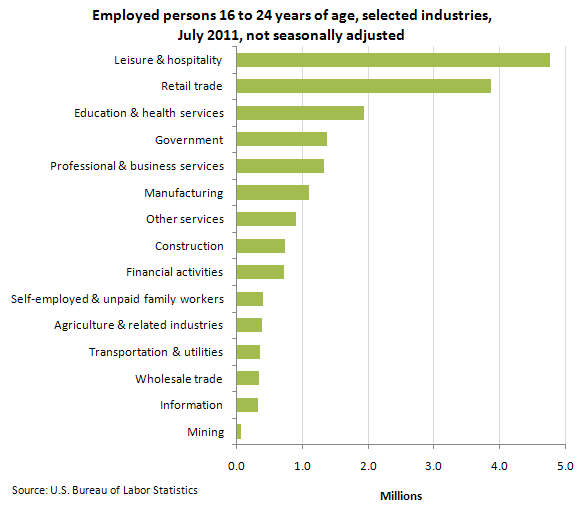August 26, 2011 (The Editor’s Desk is updated each business day.)
Youth employment in July 2011
In July, the employment-population ratio for youth—the proportion of the 16- to 24-year old civilian noninstitutional population that was employed—was 48.8 percent, a record low for the series, though only marginally lower than in July 2010. (The month of July typically is the summertime peak in youth employment.)

[Chart data]
The employment-population ratios were little changed in July from a year earlier for all major demographic groups—men (50.2 percent), women (47.3 percent), whites (52.3 percent), blacks (34.6 percent), Asians (40.5 percent), and Hispanics (42.9 percent).
In July 2011, 18.6 million 16- to 24-year-olds were employed, about the same as last year. This summer's increase in youth employment—from April to July—was 1.7 million, down slightly from last summer (1.8 million).
Twenty-six percent of employed youth (4.8 million) worked in the leisure and hospitality sector (which includes food services), about the same as in July 2010. Another 21 percent (3.9 million) were employed in the retail trade industry, also about the same proportion as last year.

[Chart data]
The number of unemployed youth in July 2011 was 4.1 million, down from 4.4 million a year ago. The youth unemployment rate declined by 1.0 percentage point over the year to 18.1 percent in July 2011, after hitting a record high for July in 2010.
These data are from the Current Population Survey. The data are not seasonally adjusted. To learn more about youth unemployment and employment, see "Employment and Unemployment Among Youth—Summer 2011" (HTML) (PDF), news release USDL 11-1246.
Related TED articles
Employment |
Men |
Unemployment |
Women |
Youth
Of interest
Spotlight on Statistics: National Hispanic Heritage Month
In this Spotlight, we take a look at the Hispanic labor force—including labor force participation, employment and unemployment, educational attainment, geographic location, country of birth, earnings, consumer expenditures, time use, workplace injuries, and employment projections.
.
Read more »

